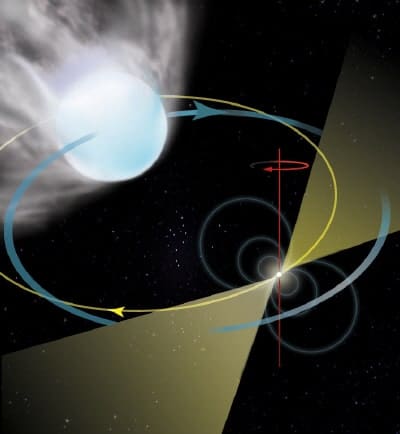Astronomers have found the fastest spinning neutron star -- or pulsar -- to date. The pulsar is actually a binary system and was discovered in a globular star cluster called Terzan 5 by Jason Hessels of McGill University in Canada and colleagues in Canada and the US. The pulsar -- known as Ter5ad -- is spinning at a rate of 716 Hz, compared to the previous record of 642 Hz. The speed indicates that the star must be less than 16 kilometres across -- a result that also helps constrain theoretical models for how matter behaves at very high densities (Sciencexpress1123430).

Most neutron stars — extremely dense stars that are heavier than the Sun, even though they measure just tens of kilometres across — rotate slower than a few times a second. However, neutron stars in binary systems can spin several hundreds of times a second because their companion stars transfer angular momentum to them. Some of these neutron stars, called millisecond pulsars, emit radio waves at periods modulated by the star’s rotation speed.
The fastest pulsar known until now was the 642-Hz pulsar B1937+21, discovered in 1982. Coincidentally, this was the also the first millisecond pulsar ever to be found. Because no other fast pulsars have been detected since, many astronomers believe that such rapidly rotating pulsars must be rare.
Hessels and colleagues decided to look for such pulsars in the globular cluster Terzan 5 using the National Astronomy Observatory’s 100-m Green Bank Telescope — the world’s largest fully steerable radio telescope. Globular clusters contain many more millisecond pulsars than our galaxy does because they contain a high density of stars in their cores, which promotes the creation of binary systems. The Canada-US team have uncovered 30 millisecond pulsars in Terzan 5 so far — including Ter5ad — in addition to the three previously known pulsars in this cluster.
Finding Ter5ad was not an easy task because the pulsar is eclipsed by its companion star for over 40% of the time. It is also a weak radio source. According to the researchers, such rapidly rotating pulsars might not be so rare after all — they are just very difficult to detect.
The size of neutron stars is also notoriously hard to measure but the team used the fast spin rate of Ter5ad to calculate its radius. “If we assume that it weighs less than two solar masses, then its radius must be less than 16 km,” Hessels told PhysicsWeb. “This helps constrain the equation of state of matter at supranuclear densities and so helps us understand the behaviour of matter at these extreme conditions.”
The astronomers now hope to discover even faster-spinning pulsars in Terzan 5. “We have found a number of new pulsars since Ter5ad, but none are spinning as fast,” says Hessels.



